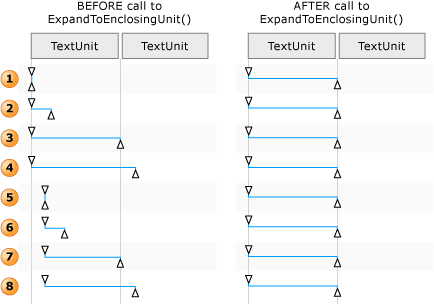ITextRangeProvider.ExpandToEnclosingUnit(TextUnit) Method
Definition
Important
Some information relates to prerelease product that may be substantially modified before it’s released. Microsoft makes no warranties, express or implied, with respect to the information provided here.
Expands the text range to the specified text unit.
public:
void ExpandToEnclosingUnit(System::Windows::Automation::Text::TextUnit unit);public void ExpandToEnclosingUnit (System.Windows.Automation.Text.TextUnit unit);abstract member ExpandToEnclosingUnit : System.Windows.Automation.Text.TextUnit -> unitPublic Sub ExpandToEnclosingUnit (unit As TextUnit)Parameters
- unit
- TextUnit
The textual unit.
Remarks
If the range is already an exact quantity of the specified units then it remains unchanged.
There is a series of steps are involved behind the scenes in order for the Move method to execute successfully.
The text range is normalized; that is, the text range is collapsed to a degenerate range at the Start endpoint, which makes the End endpoint superfluous. This step is necessary to remove ambiguity in situations where a text range spans
unitboundaries; for example, "{The U}RL https://www.microsoft.com/ is embedded in text" where "{" and "}" are the text range endpoints.The resulting range is moved backward in the DocumentRange to the beginning of the requested
unitboundary.The range is moved forward or backward in the DocumentRange by the requested number of
unitboundaries.The range is then expanded from a degenerate range state by moving the End endpoint by one requested
unitboundary.

Examples of how a text range is adjusted for Move() and ExpandToEnclosingUnit()
Note
These steps are necessary since it is common for a screen reader to read out a full word, sentence, or entire paragraph at the insertion point or any virtual cursor position.
ExpandToEnclosingUnit respects both hidden and visible text.
ExpandToEnclosingUnit defers to the next largest TextUnit supported if the given TextUnit is not supported by the control.
The order, from smallest unit to largest, is listed below.
